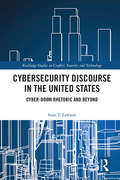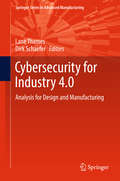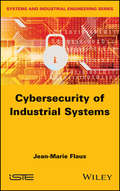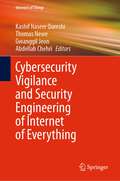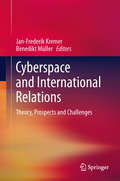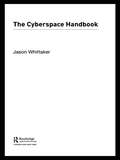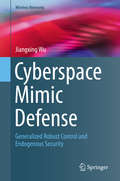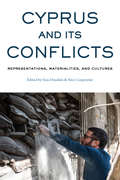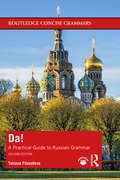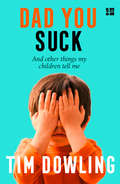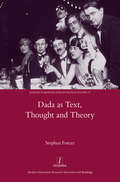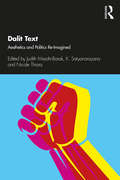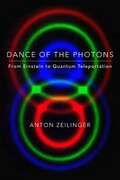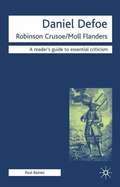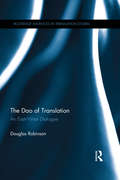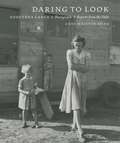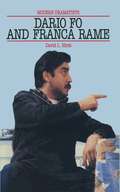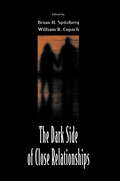- Table View
- List View
Cybersecurity Discourse in the United States: Cyber-Doom Rhetoric and Beyond (Routledge Studies in Conflict, Security and Technology)
by Sean T. LawsonThis book examines the role of cyber-doom rhetoric in the U.S. cybersecurity debate.For more than two decades, fear of "cyber-doom" scenarios—i.e. cyberattacks against critical infrastructure resulting in catastrophic physical, social, and economic impacts—has been a persistent feature of the U.S. cybersecurity debate. This is despite the fact that no cyberattack has come close to realizing such impacts. This book argues that such scenarios are part of a broader rhetoric of cyber-doom within the U.S. cybersecurity debate, and takes a multidisciplinary approach that draws on research in history, sociology, communication, psychology, and political science. It identifies a number of variations of cyber-doom rhetoric, then places them into a larger historical context, assesses how realistic the fears expressed in such rhetoric are, and finally draws out the policy implications of relying on these fears to structure our response to cybersecurity challenges. The United States faces very real cybersecurity challenges that are, nonetheless, much less dramatic than what is implied in the rhetoric. This book argues that relying on cyber-doom rhetoric to frame our thinking about such threats is counterproductive, and encourages us to develop ways of thinking and speaking about cybersecurity beyond cyber-doom.This book will be of much interest to students of cybersecurity, foreign policy, public administration, national security, and international relations in general.
Cybersecurity for Industry 4.0: Analysis for Design and Manufacturing (Springer Series in Advanced Manufacturing)
by Lane Thames Dirk SchaeferThis book introduces readers to cybersecurity and its impact on the realization of the Industry 4.0 vision. It covers the technological foundations of cybersecurity within the scope of the Industry 4.0 landscape and details the existing cybersecurity threats faced by Industry 4.0, as well as state-of-the-art solutions with regard to both academic research and practical implementations. Industry 4.0 and its associated technologies, such as the Industrial Internet of Things and cloud-based design and manufacturing systems are examined, along with their disruptive innovations. Further, the book analyzes how these phenomena capitalize on the economies of scale provided by the Internet.The book offers a valuable resource for practicing engineers and decision makers in industry, as well as researchers in the design and manufacturing communities and all those interested in Industry 4.0 and cybersecurity.
Cybersecurity of Industrial Systems
by Jean-Marie FlausHow to manage the cybersecurity of industrial systems is a crucial question. To implement relevant solutions, the industrial manager must have a clear understanding of IT systems, of communication networks and of control-command systems. They must also have some knowledge of the methods used by attackers, of the standards and regulations involved and of the available security solutions. Cybersecurity of Industrial Systems presents these different subjects in order to give an in-depth overview and to help the reader manage the cybersecurity of their installation. The book addresses these issues for both classic SCADA architecture systems and Industrial Internet of Things (IIoT) systems.
Cybersecurity of Industrial Systems
by Jean-Marie FlausHow to manage the cybersecurity of industrial systems is a crucial question. To implement relevant solutions, the industrial manager must have a clear understanding of IT systems, of communication networks and of control-command systems. They must also have some knowledge of the methods used by attackers, of the standards and regulations involved and of the available security solutions. Cybersecurity of Industrial Systems presents these different subjects in order to give an in-depth overview and to help the reader manage the cybersecurity of their installation. The book addresses these issues for both classic SCADA architecture systems and Industrial Internet of Things (IIoT) systems.
Cybersecurity Vigilance and Security Engineering of Internet of Everything (Internet of Things)
by Kashif Naseer Qureshi Thomas Newe Gwanggil Jeon Abdellah ChehriThis book first discusses cyber security fundamentals then delves into security threats and vulnerabilities, security vigilance, and security engineering for Internet of Everything (IoE) networks. After an introduction, the first section covers the security threats and vulnerabilities or techniques to expose the networks to security attacks such as repudiation, tampering, spoofing, and elevation of privilege. The second section of the book covers vigilance or prevention techniques like intrusion detection systems, trust evaluation models, crypto, and hashing privacy solutions for IoE networks. This section also covers the security engineering for embedded and cyber-physical systems in IoE networks such as blockchain, artificial intelligence, and machine learning-based solutions to secure the networks. This book provides a clear overview in all relevant areas so readers gain a better understanding of IoE networks in terms of security threats, prevention, and other security mechanisms.
Cyberspace and International Relations: Theory, Prospects and Challenges
by Jan-Frederik Kremer Benedikt MüllerCyberspace is everywhere in today’s world and has significant implications not only for global economic activity, but also for international politics and transnational social relations. This compilation addresses for the first time the “cyberization” of international relations - the growing dependence of actors in IR on the infrastructure and instruments of the internet, and the penetration of cyberspace into all fields of their activities. The volume approaches this topical issue in a comprehensive and interdisciplinary fashion, bringing together scholars from disciplines such as IR, security studies, ICT studies and philosophy as well as experts from everyday cyber-practice. In the first part, concepts and theories are presented to shed light on the relationship between cyberspace and international relations, discussing implications for the discipline and presenting fresh and innovative theoretical approaches. Contributions in the second part focus on specific empirical fields of activity (security, economy, diplomacy, cultural activity, transnational communication, critical infrastructure, cyber espionage, social media, and more) and address emerging challenges and prospects for international politics and relations.
The Cyberspace Handbook
by Jason WhittakerThe Cyberspace Handbook is a comprehensive guide to all aspects of new media, information technologies and the internet. It gives an overview of the economic, political, social and cultural contexts of cyberspace, and provides practical advice on using new technologies for research, communication and publication. The Cyberspace Handbook includes: *a glossary of over eighty key terms*a list of over ninety web resources for news and entertainment, new media and web development, education and reference, and internet and web information* specialist chapters on web design and journalism and writing on the web*Over thirty illustrations of internet material and software applications.Jason Whittaker explores how cyberspace has been constructed, how it is used and extends into areas as different as providing us immediate news or immersive games and virtual technologies for areas such as copyright and cybercrime, as well as key skills in employing the internet for research or writing and designing for the Web.
The Cyberspace Handbook
by Jason WhittakerThe Cyberspace Handbook is a comprehensive guide to all aspects of new media, information technologies and the internet. It gives an overview of the economic, political, social and cultural contexts of cyberspace, and provides practical advice on using new technologies for research, communication and publication. The Cyberspace Handbook includes: *a glossary of over eighty key terms*a list of over ninety web resources for news and entertainment, new media and web development, education and reference, and internet and web information* specialist chapters on web design and journalism and writing on the web*Over thirty illustrations of internet material and software applications.Jason Whittaker explores how cyberspace has been constructed, how it is used and extends into areas as different as providing us immediate news or immersive games and virtual technologies for areas such as copyright and cybercrime, as well as key skills in employing the internet for research or writing and designing for the Web.
Cyberspace Mimic Defense: Generalized Robust Control and Endogenous Security (Wireless Networks)
by Jiangxing WuThis book discusses uncertain threats, which are caused by unknown attacks based on unknown vulnerabilities or backdoors in the information system or control devices and software/hardware. Generalized robustness control architecture and the mimic defense mechanisms are presented in this book, which could change “the easy-to-attack and difficult-to-defend game” in cyberspace. The endogenous uncertain effects from the targets of the software/hardware based on this architecture can produce magic “mimic defense fog”, and suppress in a normalized mode random disturbances caused by physical or logic elements, as well as effects of non-probability disturbances brought by uncertain security threats.Although progress has been made in the current security defense theories in cyberspace and various types of security technologies have come into being, the effectiveness of such theories and technologies often depends on the scale of the prior knowledge of the attackers, on the part of the defender and on the acquired real-timing and accuracy regarding the attackers’ behavior features and other information. Hence, there lacks an efficient active defense means to deal with uncertain security threats from the unknown. Even if the bottom-line defense technologies such as encrypted verification are adopted, the security of hardware/software products cannot be quantitatively designed, verified or measured. Due to the “loose coupling” relationship and border defense modes between the defender and the protected target, there exist insurmountable theoretical and technological challenges in the protection of the defender and the target against the utilization of internal vulnerabilities or backdoors, as well as in dealing with attack scenarios based on backdoor-activated collaboration from both inside and outside, no matter how augmented or accumulated protective measures are adopted. Therefore, it is urgent to jump out of the stereotyped thinking based on conventional defense theories and technologies, find new theories and methods to effectively reduce the utilization of vulnerabilities and backdoors of the targets without relying on the priori knowledge and feature information, and to develop new technological means to offset uncertain threats based on unknown vulnerabilities and backdoors from an innovative perspective.This book provides a solution both in theory and engineering implementation to the difficult problem of how to avoid the uncontrollability of product security caused by globalized marketing, COTS and non-trustworthy software/hardware sources. It has been proved that this revolutionary enabling technology has endowed software/hardware products in IT/ICT/CPS with endogenous security functions and has overturned the attack theories and methods based on hardware/software design defects or resident malicious codes.This book is designed for educators, theoretical and technological researchers in cyber security and autonomous control and for business technicians who are engaged in the research on developing a new generation of software/hardware products by using endogenous security enabling technologies and for other product users. Postgraduates in IT/ICT/CPS/ICS will discover that (as long as the law of “structure determines the nature and architecture determines the security is properly used), the problem of software/hardware design defects or malicious code embedding will become the swelling of Achilles in the process of informationization and will no longer haunt Pandora’s box in cyberspace. Security and opening-up, advanced progressiveness and controllability seem to be contradictory, but there can be theoretically and technologically unified solutions to the problem.
Cyprus and its Conflicts: Representations, Materialities, and Cultures
by Vaia Doudaki and Nico CarpentierThe Mediterranean island of Cyprus is the site of enduring political, military, and economic conflict. This interdisciplinary collection takes Cyprus as a geographical, cultural and political point of reference for understanding how conflict is mediated, represented, reconstructed, experienced, and transformed. Through methodologically diverse case studies of a wide range of topics—including public art, urban spaces, and print, broadcast and digital media—it assembles an impressively multifaceted perspective, one that provides broad insights into the complex interplay of culture, conflict, and identity.
Da!: A Practical Guide to Russian Grammar (Routledge Concise Grammars)
by Tatiana FilosofovaThis fully revised second edition of Da! A Practical Guide to Russian Grammar is a concise and contemporary reference grammar and workbook for intermediate-level students. The book contains clear explanations of the core areas of Russian grammar. Each point is illustrated with examples of contemporary language usage showing you how grammar works in practice while at the same time enhancing your vocabulary and cultural knowledge. Every chapter ends with a variety of exercises to test your progress and consolidate your understanding. Now revised with more exercises and enhanced e-resources. Suitable for intermediate-level students, Da! A Practical Guide to Russian Grammar is an invaluable resource for both classroom and self-study.
DAB Digital Radio: Licensed To Fail (PDF)
by Grant GoddardGrant Goddard presents a blow-by-blow account of the efforts to implement 'DAB' as a replacement for FM and AM radio in Britain, from the deliberations of the Digital Radio Working Group in 2008 to the legislation of the Digital Economy Act during the final days of the Labour government in 2010.
Dab Digital Radio (PDF): Licensed To Fail
by Grant GoddardGrant Goddard presents a blow-by-blow account of the efforts to implement 'DAB' as a replacement for FM and AM radio in Britain, from the deliberations of the Digital Radio Working Group in 2008 to the legislation of the Digital Economy Act during the final days of the Labour government in 2010.
Dad You Suck: And other things my children tell me
by Tim DowlingWritten with self-excoriating candour and the driest humour, comes a book about being a dad from one of our best loved journalists.
Dada as Text, Thought and Theory
by Stephen ForcerThe Dada movement, revered as perhaps the purest form of cultural subversion and provocation in 20th-century Europe, has been a victim of the readiness with which cultural historians have swallowed its own propaganda. Based on extensive close analysis of French-language Dada work in its original form, and offering English translations throughout, this major reappraisal looks at a broad range of media and topics - including poetry, film, philosophy, and quantum physics - in order to get beyond Dada's typecasting as avant-garde anti-hero. Work by women writers and other marginalized figures combines with that of canonical Dadaists to present Dada in a radically new set of guises: poetic and textually subtle; intellectually and philosophically meaningful; peaceable and quasi-Buddhist; and, perhaps most uncomfortably of all, conformist and reactionary.
Dada as Text, Thought and Theory
by Stephen ForcerThe Dada movement, revered as perhaps the purest form of cultural subversion and provocation in 20th-century Europe, has been a victim of the readiness with which cultural historians have swallowed its own propaganda. Based on extensive close analysis of French-language Dada work in its original form, and offering English translations throughout, this major reappraisal looks at a broad range of media and topics - including poetry, film, philosophy, and quantum physics - in order to get beyond Dada's typecasting as avant-garde anti-hero. Work by women writers and other marginalized figures combines with that of canonical Dadaists to present Dada in a radically new set of guises: poetic and textually subtle; intellectually and philosophically meaningful; peaceable and quasi-Buddhist; and, perhaps most uncomfortably of all, conformist and reactionary.
Dalit Text: Aesthetics and Politics Re-imagined
by Judith Misrahi-Barak K. Satyanarayana Nicole ThiaraThis book, companion to the much-acclaimed Dalit Literatures in India, examines questions of aesthetics and literary representation in a wide range of Dalit literary texts. It looks at how Dalit literature, born from the struggle against social and political injustice, invokes the rich and complex legacy of oral, folk and performative traditions of marginalised voices. The essays and interviews systematically explore a range of literary forms, from autobiographies, memoirs and other testimonial narratives, to poems, novels or short stories, foregrounding the diversity of Dalit creation. Showcasing the interplay between the aesthetic and political for a genre of writing that has ‘change’ as its goal, the volume aims to make Dalit writing more accessible to a wider public, for the Dalit voices to be heard and understood. The volume also shows how the genre has revolutionised the concept of what literature is supposed to mean and define. Effervescent first-person accounts, socially militant activism and sharp critiques of a little-explored literary terrain make this essential reading for scholars and researchers of social exclusion and discrimination studies, literature (especially comparative literature), translation studies, politics, human rights and culture studies.
Dalit Text: Aesthetics and Politics Re-imagined
by K. Satyanarayana Judith Misrahi-Barak Nicole ThiaraThis book, companion to the much-acclaimed Dalit Literatures in India, examines questions of aesthetics and literary representation in a wide range of Dalit literary texts. It looks at how Dalit literature, born from the struggle against social and political injustice, invokes the rich and complex legacy of oral, folk and performative traditions of marginalised voices. The essays and interviews systematically explore a range of literary forms, from autobiographies, memoirs and other testimonial narratives, to poems, novels or short stories, foregrounding the diversity of Dalit creation. Showcasing the interplay between the aesthetic and political for a genre of writing that has ‘change’ as its goal, the volume aims to make Dalit writing more accessible to a wider public, for the Dalit voices to be heard and understood. The volume also shows how the genre has revolutionised the concept of what literature is supposed to mean and define. Effervescent first-person accounts, socially militant activism and sharp critiques of a little-explored literary terrain make this essential reading for scholars and researchers of social exclusion and discrimination studies, literature (especially comparative literature), translation studies, politics, human rights and culture studies.
Dance Of The Photons (PDF): From Einstein To Quantum Teleportation
by Anton ZeilingerEinstein's steadfast refusal to accept certain aspects of quantum theory was rooted in his insistence that physics has to be about reality. Accordingly, he once derided as "spooky action at a distance" the notion that two elementary particles far removed from each other could nonetheless influence each other's properties--a hypothetical phenomenon his fellow theorist Erwin Schrödinger termed "quantum entanglement." In a series of ingenious experiments conducted in various locations--from a dank sewage tunnel under the Danube River to the balmy air between a pair of mountain peaks in the Canary Islands--the author and his colleagues have demonstrated the reality of such entanglement using photons, or light quanta, created by laser beams. In principle the lessons learned may be applicable in other areas, including the eventual development of quantum computers.
Daniel Defoe - Robinson Crusoe/Moll Flanders (PDF)
by Paul BainesDefoe's Robinson Crusoe (1719) and Moll Flanders (1721) together defined a new way of writing fiction in the eighteenth century. Each was highly controversial in Defoe's time, and each has generated a very large amount of criticism since. This Guide examines the major trends and movements in critical interpretation of these two popular and widely-studied novels, from the earliest reception history to the present day. The thematic and chronological organization of material points out similarities and differences between the two books, and maps Defoe studies onto some of the obvious lines of development that criticism in general has taken over the last century in particular, including feminist, ideological and postcolonial perspectives. The volume also features a section on adaptations of the novels in film and other media.
The Dao of Translation: An East-West Dialogue (Routledge Advances in Translation and Interpreting Studies)
by Douglas RobinsonThe Dao of Translation sets up an East-West dialogue on the nature of language and translation, and specifically on the "unknown forces" that shape the act of translation. To that end it mobilizes two radically different readings of the Daodejing (formerly romanized as the Tao Te Ching): the traditional "mystical" reading according to which the Dao is a mysterious force that cannot be known, and a more recent reading put forward by Sinologists Roger T. Ames and David L. Hall, to the effect that the Dao is simply the way things happen. Key to Ames and Hall’s reading is that what makes the Dao seem both powerful and mysterious is that it channels habit into action—or what the author calls social ecologies, or icoses. The author puts Daoism (and ancient Confucianism) into dialogue with nineteenth-century Western theorists of the sign, Charles Sanders Peirce and Ferdinand de Saussure (and their followers), in order to develop an "icotic" understanding of the tensions between habit and surprise in the activity of translating. The Dao of Translation will interest linguists and translation scholars. This book will also engage researchers of ancient Chinese philosophy and provide Western scholars with a thought-provoking cross-examination of Eastern and Western perspectives.
The Dao of Translation: An East-West Dialogue (Routledge Advances in Translation and Interpreting Studies)
by Douglas RobinsonThe Dao of Translation sets up an East-West dialogue on the nature of language and translation, and specifically on the "unknown forces" that shape the act of translation. To that end it mobilizes two radically different readings of the Daodejing (formerly romanized as the Tao Te Ching): the traditional "mystical" reading according to which the Dao is a mysterious force that cannot be known, and a more recent reading put forward by Sinologists Roger T. Ames and David L. Hall, to the effect that the Dao is simply the way things happen. Key to Ames and Hall’s reading is that what makes the Dao seem both powerful and mysterious is that it channels habit into action—or what the author calls social ecologies, or icoses. The author puts Daoism (and ancient Confucianism) into dialogue with nineteenth-century Western theorists of the sign, Charles Sanders Peirce and Ferdinand de Saussure (and their followers), in order to develop an "icotic" understanding of the tensions between habit and surprise in the activity of translating. The Dao of Translation will interest linguists and translation scholars. This book will also engage researchers of ancient Chinese philosophy and provide Western scholars with a thought-provoking cross-examination of Eastern and Western perspectives.
Daring to Look: Dorothea Lange's Photographs and Reports from the Field
by Anne Whiston SpirnDaring to Look presents never-before-published photos and captions from Dorothea Lange’s fieldwork in California, the Pacific Northwest, and North Carolina during 1939. Lange’s images of squatter camps, benighted farmers, and stark landscapes are stunning, and her captions—which range from simple explanations of settings to historical notes and biographical sketches—add unexpected depth, bringing her subjects and their struggles unforgettably to life, often in their own words. When Lange was dismissed from the Farm Security Administration at the end of 1939, these photos and field notes were consigned to archives, where they languished, rarely seen. With Daring to Look, Anne Whiston Spirn not only returns them to the public eye, but sets them in the context of Lange’s pioneering life, work, and struggle for critical recognition—firmly placing Lange in her rightful position at the forefront of American photography. “[A] thoughtful and meticulously researched account of Lange’s career. . . . Spirn, a photographer herself, traces Lange’s path, visiting her locations and subjects in a fascinating series of ‘then and now’ shots.”—Publishers Weekly “Dorothea Lange has long been regarded as one of the most brilliant photographic witnesses we have ever had to the peoples and landscapes of America, but until now no one has fully appreciated the richness with which she wove images together with words to convey her insights about this nation. We are lucky indeed that Anne Whiston Spirn, herself a gifted photographer and writer, has now recovered Lange’s field notes and woven them into a rich tapestry of texts and images to help us reflect anew on Lange’s extraordinary body of work.”—William Cronon, author of Nature’s Metropolis
Dario Fo and Franca Rame
by David HirstDario Fo is Italy's most celebrated contemporary dramatist. His plays have also achieved wide recognition in Britain. This book examines the work of Dario Fo, his major plays and his remarkable contribution to performance.
The Dark Side of Close Relationships
by Brain H. Spitzberg William R. CupachThis collection of essays represents a follow-up to the editors' 1994 publication, The Dark Side of Interpersonal Communication. In the preface to that collection of essays, they argued that "To fully understand how people function effectively requires us to consider how individuals cope with social interaction that is difficult, problematic, challenging, distressing, and disruptive." In this companion volume, the focus expands from social interaction to close relationships. Aside from the inherent need to investigate the bad as well as the good of interpersonal relationships, the editors and their colleagues simply find the dark side metaphor to be intellectually arousing. It stimulates investigation of important yet often neglected phenomena, and it especially encourages consideration of the hidden and forbidden, and the paradoxical and ironic elements of human relating. This volume assembles the cutting-edge work of first rate scholars from the ranks of communication, psychology, sociology, and cognate disciplines. As in the previous text, the subject matter and stylistic approaches are diverse, reflecting the broad and interdisciplinary domain that is the dark side of human affairs. The selection of topics is somewhat selective, reflecting only a sample of emerging scholarship in the interdisciplinary study of relationships. These internationally recognized scholars examine various topics related to the dark side, including fatal attractions, jealousy and envy, misunderstanding, gossip, conflict, codependence, sexual coercion, stalking, relationship termination, unrequited love, and mental health problems in relationships. Some chapters present original data and models, whereas others reconfigure the way in which the understandings of relationships can be better understood. In addition, the bookend chapters examine the ideology, nature, and problems of dark side scholarship. Collectively, the scholarly journeys made in this volume are intended to illustrate the complexities--both moral and functional--involved in close relationship processes. The intent is neither to valorize nor demonize the darker aspects of close relationships, but rather to emphasize their importance to the day-to-day "doing" of relationships. Only by accepting such processes as integral to relationships can their role be fully understood.
